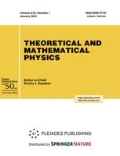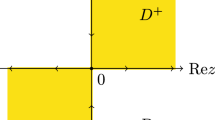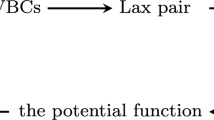Abstract
We study a matrix Riemann–Hilbert (RH) problem for the modified Landau–Lifshitz (mLL) equation with nonzero boundary conditions at infinity. In contrast to the case of zero boundary conditions, multivalued functions arise during direct scattering. To formulate the RH problem, we introduce an affine transformation converting the Riemann surface into the complex plane. In the direct scattering problem, we study the analyticity, symmetries, and asymptotic behavior of Jost functions and the scattering matrix in detail. In addition, we find the discrete spectrum, residue conditions, trace formulas, and theta conditions in two cases: with simple poles and with second-order poles present in the spectrum. We solve the inverse problems using the RH problem formulated in terms of Jost functions and scattering coefficients. For further studying the structure of the soliton waves, we consider the dynamical behavior of soliton solutions for the mLL equation with reflectionless potentials. We graphically analyze some remarkable characteristics of these soliton solutions. Based on the analytic solutions, we discuss the influence of each parameter on the dynamics of the soliton waves and breather waves and propose a method for controlling such nonlinear phenomena.











Similar content being viewed by others
References
Y. B. Bazaliy, B. A. Jones, and S.-C. Zhang, “Modification of the Landau–Lifshitz equation in the presence of a spin-polarized current in colossal- and giant-magnetoresistive materials,” Phys. Rev. B, 57, R3213–R23216 (1998); arXiv:cond-mat/9706132v1 (1997).
J. C. Slonczewski, “Excitation of spin waves by an electric current,” J. Magn. Magn. Mater., 195, L261–L268 (1999).
A. M. Kosevich, B. A. Ivanov, and A. S. Kovalev, “Magnetic solitons,” Phys. Rep., 194, 117–238 (1990).
P.-B. He and W. M. Liu, “Nonlinear magnetization dynamics in a ferromagnetic nanowire with spin current,” Phys. Rev. B, 72, 064410 (2005).
Z.-D. Li and Q.-Y. Li, “Dark soliton interaction of spinor Bose–Einstein condensates in an optical lattice,” Ann. Phys. (N. Y.), 322, 1961–1971 (2007); arXiv:1012.5469v1 [cond-mat.other] (2010).
R. Hirota, “Exact envelope-soliton solutions of a nonlinear wave equation,” J. Math. Phys., 14, 805–809 (1973).
C.-Q. Su, Y.-Y. Wang, X.-Q. Liu, and N. Qin, “Conservation laws, modulation instability, and rogue waves for the localized magnetization with spin torque,” Commun. Nonlinear Sci. Numer. Simul., 48, 236–245 (2017).
V. B. Matveev and M. A. Salle, Darboux Transformations and Solitons (Springer Ser. Nonlin. Dyn., Vol. 5), Springer, Berlin (1991).
Z.-D. Li, Q.-Y. Li, L. Li, and W. M. Liu, “Soliton solution for the spin current in a ferromagnetic nanowire,” Phys. Rev. E, 76, 026605 (2007); arXiv:0708.3120v1 [cond-mat.other] (2007).
F. Zhao, Z.-D. Li, Q.-Y. Li, L. Wen, G. Fu, and W. M. Liu, “Magnetic rogue wave in a perpendicular anisotropic ferromagnetic nanowire with spin-transfer torque,” Ann. Phys., 327, 2085–2095 (2012); arXiv:1108.3252v2 [cond-mat.mtrl-sci] (2011).
V. S. Gerdzhikov and P. P. Kulish, “On the multicomponent nonlinear Schrödinger equation in the case of nonvanishing boundary conditions [in Russian],” Zap. Nauchn. Semin. Leningr. Otd. Mat. Inst. Steklova, 131, 34–46 (1983).
B. Prinari, M. J. Ablowitz, and G. Biondini, “Inverse scattering transform for the vector nonlinear Schrödinger equation with nonvanishing boundary conditions,” J. Math. Phys., 47, 063508 (2006).
M. J. Ablowitz, G. Biondini, and B. Prinari, “Inverse scattering transform for the integrable discrete nonlinear Schrödinger equation with nonvanishing boundary conditions,” Inverse Problems, 23, 1711–1758 (2007).
X.-D. Luo, “Inverse scattering transform for the complex reverse space–time nonlocal modified Korteweg–de Vries equation with nonzero boundary conditions and constant phase shift,” Chaos, 29, 073118 (2019).
B. Prinari, G. Biondini, and A. D. Trubatch, “Inverse scattering transform for the multi-component nonlinear Schrödinger equation with nonzero boundary conditions,” Stud. Appl. Math., 126, 245–302 (2011).
F. Demontis, B. Prinari, C. van der Mee, and F. Vitales, “The inverse scattering transform for the defocusing nonlinear Schrödinger equations with nonzero boundary condition,” Stud. Appl. Math., 131, 1–40 (2013).
F. Demontis, B. Prinari, C. van der Mee, and F. Vitale, “The inverse scattering transform for the focusing nonlinear Schrödinger equation with asymmetric boundary conditions,” J. Math. Phys., 55, 101505 (2014).
G. Biondini, E. Fagerstrom, and B. Prinari, “Inverse scattering transform for the defocusing nonlinear Schrödinger equation with fully asymmetric non-zero boundary conditions,” Phys. D, 333, 117–136 (2016).
J. Ieda, M. Uchiyama, and M. Wadati, “Inverse scattering method for square matrix nonlinear Schrödinger equation under nonvanishing boundary conditions,” J. Math. Phys., 48, 013507 (2007); arXiv:nlin/0603010v2 (2006).
G. Zhang and Z. Yan, “Inverse scattering transforms and \(N\)-double-pole solutions for the derivative NLS equation with zero/non-zero boundary conditions,” arXiv:1812.02387v1 [nlin.SI] (2018).
J. Zhu and L. Wang, “Kuznetsov–Ma solution and Akhmediev breather for TD equation,” Commun. Nonlinear Sci. Numer. Simul., 67, 555–567 (2019).
J. Zhu, L. Wang, and X. Geng, “Riemann–Hilbert approach to TD equation with nonzero boundary condition,” Front. Math. China., 13, 1245–1265 (2018).
M. J. Ablowitz and H. Segur, Solitons and the Inverse Scattering Transform, SIAM, Philadelphia (1981).
S.-F. Tian, “Initial-boundary value problems for the general coupled nonlinear Schrödinger equation on the interval via the Fokas method,” J. Differ. Equ., 262, 506–558 (2017).
S.-F. Tian, “The mixed coupled nonlinear Schrödinger equation on the half-line via the Fokas method,” Proc. Roy. Soc. London Ser. A, 472, 20160588 (2016).
W.-Q. Peng, S.-F. Tian, X.-B. Wang, T.-T. Zhang, and Y. Fang, “Riemann–Hilbert method and multi-soliton solutions for three-component coupled nonlinear Schrödinger equations,” J. Geom. Phys., 146, 103508 (2019).
J. J. Yang, S. F. Tian, W. Q. Peng, and T. T. Zhang, “The \(N\)-coupled higher-order nonlinear Schrödinger equation: Riemann–Hilbert problem and multi-soliton solutions,” Math. Meth. Appl. Sci., 43, 2458–2472 (2020).
Z.-Q. Li, S.-F. Tian, W.-Q. Peng, and J.-J. Yang, “Inverse scattering transform and soliton classification of higher-order nonlinear Schrödinger–Maxwell–Bloch equations,” Theor. Math. Phys., 203, 709–725 (2020).
D.-S. Wang, D.-J. Zhang, and J. Yang, “Integrable properties of the general coupled nonlinear Schrödinger equations,” J. Math. Phys., 51, 023510 (2010).
L. Ai and J. Xu, “On a Riemann–Hilbert problem for the Fokas–Lenells equation,” Appl. Math. Lett., 87, 57–63 (2019).
Y. Zhang, Y. Cheng, and J. He, “Riemann–Hilbert method and \(N\)-soliton for two-component Gerdjikov–Ivanov equation,” J. Nonliner Math. Phys., 24, 210–223 (2017).
B. Guo, N. Liu, and Y. Wang, “A Riemann–Hilbert approach for a new type coupled nonlinear Schrödinger equations,” J. Math. Anal. Appl., 459, 145–158 (2018).
C. S. Gardner, J. M. Greene, M. D. Kruskal, and R. M. Miura, “Method for solving the Korteweg–de Vries equation,” Phys. Rev. Lett., 19, 1095–1097 (1967).
A. B. de Monvel and D. Shepelsky, “Riemann–Hilbert approach for the Camassa–Holm equation on the line,” C. R. Math. Acad. Sci. Paris, 343, 627–632 (2006).
D.-S. Wang, B. Guo, and X. Wang, “Long-time asymptotics of the focusing Kundu–Eckhaus equation with nonzero boundary conditions,” J. Differ. Equ., 266, 5209–5253 (2019).
S.-F. Tian and T.-T. Zhang, “Long-time asymptotic behavior for the Gerdjikov–Ivanov type of derivative nonlinear Schrödinger equation with time-periodic boundary condition,” Proc. AMS, 146, 1713–1729 (2018).
W.-X. Ma, “Riemann–Hilbert problems and \(N\)-soliton solutions for a coupled mKdV system,” J. Geom. Phys., 132, 45–54 (2018).
X. Geng and J. Wu, “Riemann–Hilbert approach and \(N\)-soliton solutions for a generalized Sasa–Satsuma equation,” Wave Motion, 60, 62–72 (2016).
S.-F. Tian, “Initial-boundary value problems of the coupled modified Korteweg–de Vries equation on the half-line via the Fokas method,” J. Phys. A: Math. Theor., 50, 395204 (2017).
A. A. Zabolotskii, “Solution of the reduced anisotropic Maxwell–Bloch equations by using the Riemann–Hilbert problem,” Phys. Rev. E, 75, 036612 (2007).
L. A. Takhtajan and L. D. Faddeev, Hamiltonian Approach in the Theory of Solitons [in Russian], Nauka, Moscow (1986); English transl.: L. D. Faddeev and L. A. Takhtajan, Hamiltonian Methods in the Theory of Solitons, Springer, Berlin (1987).
M. J. Ablowitz and A. S. Fokas, Complex Variables: Introduction and Applications, Cambridge Univ. Press, Cambridge (2003).
P. Henrici, Applied and Computational Complex Analysis, Wiley, New York (1974).
G. Biondini and G. Kovačič, “Inverse scattering transform for the focusing nonlinear Schrödinger equation with nonzero boundary conditions,” J. Math. Phys., 55, 031506 (2014).
N. Bleistein and R. A. Handelsman, Asymptotic Expansions of Integrals, Dover, New York (1986).
M. Pichler and G. Biondini, “On the focusing non-linear Schrödinger equation with non-zero boundary conditions and double poles,” IMA J. Appl. Math., 82, 131–151 (2017).
G. Zhang, S. Chen, and Z. Yan, “Focusing and defocusing Hirota equations with non-zero boundary conditions: inverse scattering transforms and soliton solutions,” Commun. Nonlinear Sci. Numer. Simul., 80, 104927 (2020).
Acknowledgments
The authors thank the editor and a referee for their valuable comments and suggestions.
Funding
This research was supported by the National Natural Science Foundation of China (Grant No. 11975306), the Natural Science Foundation of Jiangsu Province (Grant No. BK20181351), the Six Talent Peaks Project in Jiangsu Province (Grant No. JY-059), the Fundamental Research Fund for the Central Universities (Grant Nos. 2019ZDPY07 and 2019QNA35), the Assistance Program for Future Outstanding Talents of China University of Mining and Technology (Grant No. 2020WLJCRCZL031), and the Postgraduate Research & Practice Innovation Program of Jiangsu Province (Grant No. KYCX20_2038).
Author information
Authors and Affiliations
Corresponding author
Ethics declarations
The authors declare no conflicts of interest.
Rights and permissions
About this article
Cite this article
Yang, JJ., Tian, SF. Riemann–Hilbert problem for the modified Landau–Lifshitz equation with nonzero boundary conditions. Theor Math Phys 205, 1611–1637 (2020). https://doi.org/10.1134/S0040577920120053
Received:
Revised:
Accepted:
Published:
Issue Date:
DOI: https://doi.org/10.1134/S0040577920120053




